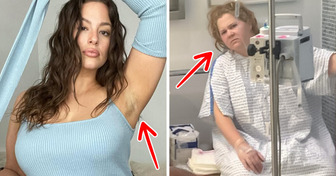11 Real Stories Where the Last Detail Changed Everything


The images of graceful ballerinas are often used in popular culture, especially in movies. Thanks to these pictures, we’ve learned the backstage secrets of this profession, but there are also a great number of myths that come along with them. Real-life ballet dancers decided to bust some of the myths that we’ve been believing in all this time.
It’s often said that ballerinas have an exceptionally high pain threshold — and for good reason. Dancing on pointe shoes every day can be extremely painful. Interestingly, they avoid cutting their toenails too short, since the constant pressure on their feet can cause ingrown nails if the nails are trimmed too close.
It seems like slender ballerinas would only be able to eat very little, and this stereotype is often promoted in movies. Many of us probably remember that Nina, from the movie Black Swan, would eat mainly cucumbers and grapefruits, and when her mother bought a cake, she refused to eat it.
Here is what real ballerinas say about this, “We sometimes train from 10 to 7 with very short breaks. Therefore, we need to eat well because you need fuel for that. Yes, there is a skinny culture in ballet. But we understand that starving yourself and trying to get a full performance out, that’s just not possible for a human to do that.”
One ballet dancer described her typical daily diet like this, “My breakfast is coffee and avocado toast with scrambled eggs. I have a banana or an apple for a snack. My lunch usually consists of a soup. And I have a salad and a steak for dinner. But sometimes I can also eat potato chips, chocolate, or ice cream.” Another ballerina said, “For breakfast, I definitely have to eat something high in carbs so that I have enough energy: pasta, pizza, Nutella bread, or a cheese sandwich.”
It might seem like leg warmers serve the same purpose during a rehearsal as a warm top — they keep dancers’ muscles warm. And in movies, ballerinas often work out in them. However, this item of clothing is not that common in real-life ballet.
According to ballerinas, it’s important for mentors to see the position of dancers’ knees during dancing, while thick and long leg warmers can hide them. Even if a dancer chooses to wear this item of clothing, she usually does so during a home workout, like the heroine of the movie Flashdance.
On the other hand, the movie scenes where a dancer is wearing only one leg warmer are more believable. According to the representatives of the Australian Ballet, this means that a dancer coddles a niggling injury in that leg.
Movie ballerinas always appear on screen with clean-shaven armpits, even during rehearsals. It seems that the absence of hair in this area is one of the professional requirements.
Of course, during the season, ballerinas are required to dance with perfect armpits, so they not only shave this area but also use a number of remedies for skin irritation and ingrown hairs. But some of them admit that they let their armpits have some “rest” when they don’t have to go on stage.
You are unlikely to see a ballet dancer with short hair in a movie. Many people even believe that since a ballerina has to wear a bun during her performances, this means that her hair should be long enough to be put up like that.
In reality, there is no such requirement for women because they can wear a fake bun when necessary. According to one professional ballerina, a ballet dancer can even have a pixie cut.
As a rule, movie ballerinas have problems with their feet. Due to constant dancing in pointe shoes, their feet get injured, so dancers have to endure pain for the sake of art. Surely, their toes and nails look quite unpresentable.
However, according to real ballerinas, this is not something that happens regularly. Of course, they can have corns and calluses, just like anyone else, but dancers definitely don’t suffer the way it’s shown in movies. In addition, they have many tricks that help them protect their feet from injuries. For example, there are special gel pads that help them dance in a much more comfortable way.
For people who are not ballet-theater regulars, the very phrase “a ballerina costume” exclusively evokes associations with the image of a fairy whose invariable attribute is a tutu. So in movies, dancers usually perform in tutus that are delicate shades of pink or white, and they resemble fairy tale princesses.
In reality, ballet costumes can be strikingly diverse. Here’s what a real dancer says about this, “Throughout my career, I maybe wore a pink tutu twice when I played Sugar Plum and Aurora. At all other times, it was dresses, leotards, and some interesting costumes in different colors.”
In movies and TV shows about ballet, you can often see a scene where a dancer significantly alters her pointe shoes: she rips them apart, performs some manipulations with the fabric, then sews them back. However, this approach is now considered obsolete. There was a time when pointe shoes were made from burlap, which made them wear out quickly and require some modifications. So, dancers had to fill the shoebox with epoxy varnish or glue before wearing them.
Modern pointe shoes don’t need this because the shoebox is made from plastic for better rigidity. Therefore, it’s no longer necessary to remake your pointe shoes. But it is still true that each ballerina adds ribbons and elastic bands herself because new pointe shoes usually come without them.
The main characters in movies about ballet are usually very unlucky when it comes to partners: these men drop them on the floor or push them. And after an accident like that, ballerinas are lying picturesquely on the stage and waiting for help.
But according to real ballerinas, this never happens in real life. “It looks very weird. Even after being seriously injured, a dancer will do their best to continue the performance. When something like this happens on stage, dancers react very quickly to make sure the audience doesn’t notice anything.”
Representatives of one world-famous ballet company also mentioned that it’s a myth that a dancer can say goodbye to their career after a serious injury. According to them, this is possible but highly unlikely. Ballerinas tend to be regularly injured due to intense physical activity, but thanks to the efforts of physical therapists, they quickly get back on the rails.
By the way, some theaters use unusual tricks to prevent falls. For example, members of the Australian Ballet pour Coke on the stage to make the floor slightly sticky and prevent dancers from slipping.
Pancake tutu keeps its perfectly horizontal shape thanks to a thin metal hoop sewn into one of the layers. Because of this, tutus are quite difficult to care for and are rarely washed in full — water can easily ruin their delicate structure and appearance.
After each performance, the theater staff clean only the attached panties and disinfect the lining with a special spray to remove any traces of sweat. Occasionally, the tutus are sent to a dry cleaner for a more thorough refresh.
Be sure to check out our other article, where we reveal fascinating facts about gymnasts that will leave ordinary people speechless.











